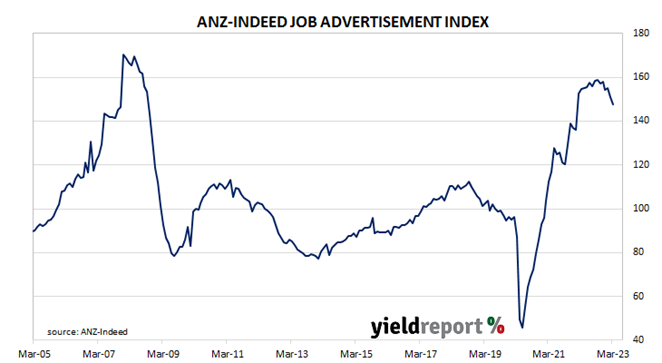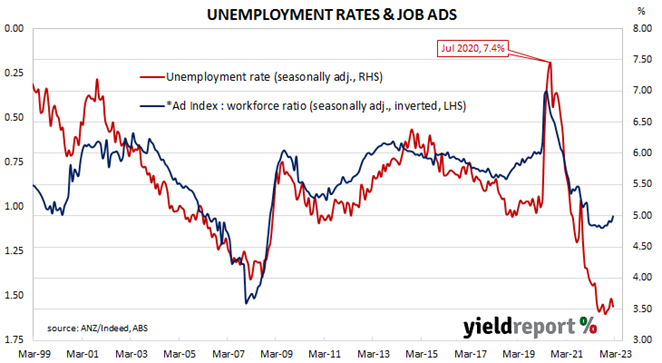Summary: Job ads down 2.4% in March; 4.7% lower than March 2022; unfilled labour demand “significant”; ANZ: labour market will remain very tight through 2023; ad index-to-workforce ratio falls from 1.05 to 1.03.
From mid-2017 onwards, year-on-year growth rates in the total number of Australian job advertisements consistently exceeded 10%. That was until mid-2018 when the annual growth rate fell back markedly. 2019 was notable for its reduced employment advertising and this trend continued into the first quarter of 2020. Advertising plunged in April and May of 2020 as pandemic restrictions took effect but then recovered quite quickly.
According to the latest ANZ-Indeed figures, total advertisements decreased by 2.4% in March on a seasonally adjusted basis. The fall followed a 2.6% loss in February and a 0.6% rise in January. On a 12-month basis, total job advertisements were 4.7% lower than in March 2022, down from February’s figure of -1.0%.
“[The] ANZ-Indeed Australian Job Ads [Index] has fallen 7.2% from its September 2022 peak but is still more than 50% above its pre-pandemic level, indicating the volume of unfilled labour demand remains significant,” noted ANZ senior economist Catherine Birch.
The figures were released on the same day as several other reports and Commonwealth Government bond yields generally rose modestly. By the close of business, the 3-year ACGB yield had gained 4bps to 2.95%, the 10-year yield had added 2bps to 3.32% while the 20-year yield finished 1bp higher at 3.74%.
In the cash futures market, expectations regarding future rate cuts softened. At the end of the day, contracts implied the cash rate would rise from the current rate of 3.57% to average 3.60% in April and then increase to an average of 3.655% through May. August 2023 contracts implied a 3.585% average cash rate while November 2023 contracts implied 3.495%, 7bps below the current cash rate.
Birch also said the view the labour market is still tight is consistent with recent data from NAB, ACCI and the ABS. “As such, we expect the labour market will remain very tight through 2023, with unemployment staying below 4%.”
The inverse relationship between job advertisements and the unemployment rate has been quite strong (see below chart), although ANZ themselves called the relationship between the two series into question in early 2019. A lower job advertisement index as a proportion of the labour force is suggestive of higher unemployment rates in the near future while a rising ratio suggests lower unemployment rates will follow. March’s ad index-to-workforce ratio fell from 1.05 to 1.03.
In 2008/2009, advertisements plummeted and Australia’s unemployment rate jumped from 4% to nearly 6% over a period of 15 months. When a more dramatic fall in advertisements took place in April 2020, the unemployment rate responded much more quickly.



